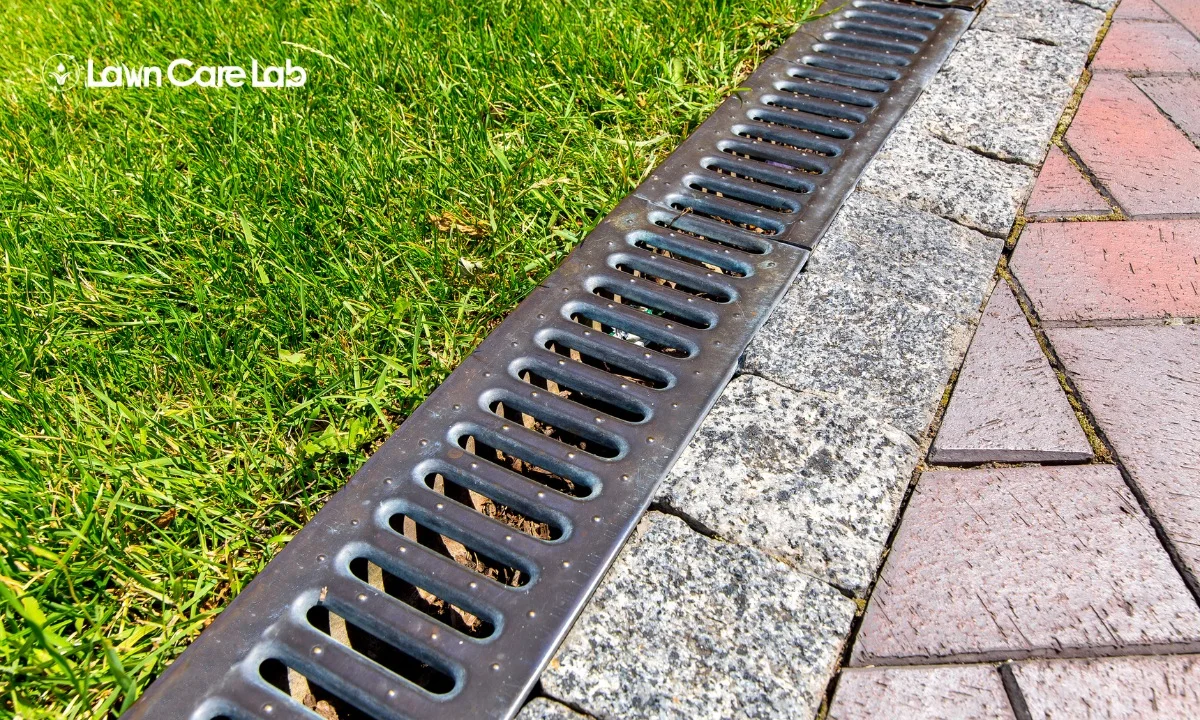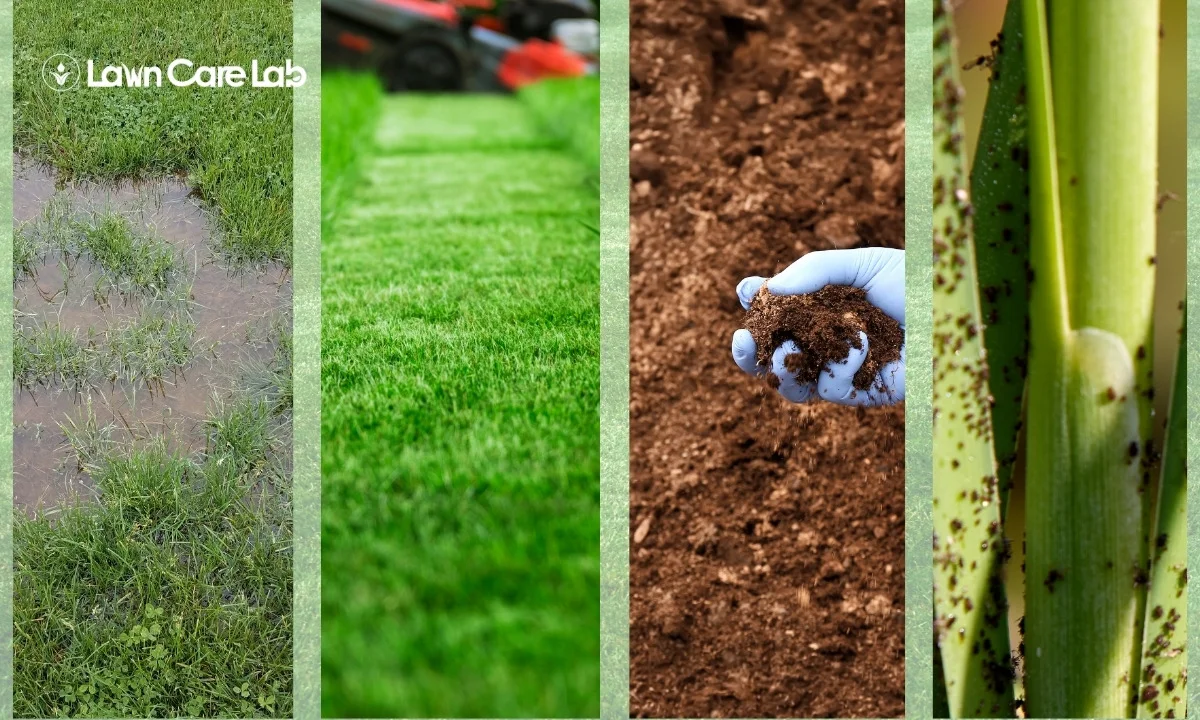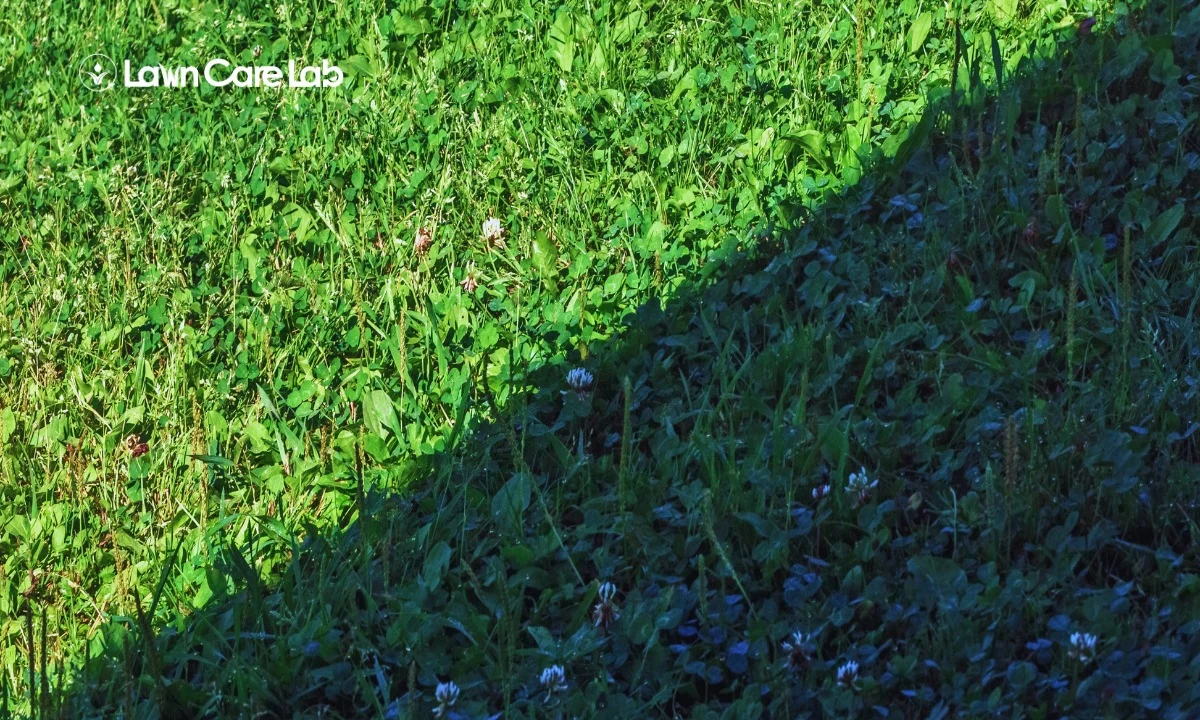Has your labor over your garden not yielded the lush results you were aiming for? The culprit could be inadequate drainage.
Let’s delve into the world of garden irrigation, exploring common hitches, creative fixes, and the surprising perks of correct water handling.
It’s about time we unravel the mystery surrounding this vital yet commonly disregarded facet of gardening. Are you prepared to unlock the pathway to a verdant, thriving lawn with lawn drainage demystified?
Let’s get on with it.
Table of Contents
Introduction to Lawn Drainage
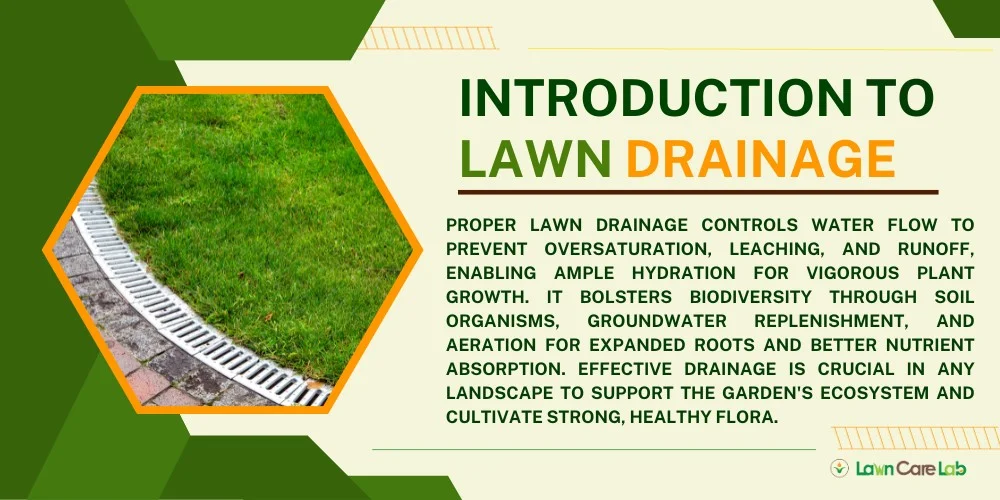
Ever pondered about lawn drainage and its importance for your backyard?
In a nutshell, it’s all about efficiently controlling water to avoid over-saturation and safeguarding the well-being of your greenery.
Lawn Drainage is a crucial cog in the machinery of your garden’s ecosystem, boosting the vigor of your grass and flora.
What is lawn drainage, and why should you care
Lawn drainage refers to how water effectively travels through your soil, a key factor in keeping your garden lush and healthy. The right drainage feeds your plants, prevents soil erosion, and filters water back into your ecosystem.
However, Poor drainage can lead to waterlogged soil, plant diseases, and turf loss. Look for signs like wilting plants, soggy patches, and increased moss or fungi growth.
Good lawn drainage is crucial for plant growth. Advancements in this field can help your garden thrive.
The role of drainage in a garden’s ecosystem
Proper drainage is pivotal for the garden’s ecosystem. It not only manages water but also contributes to plant growth and biodiversity.
Consider the role of microorganisms in the soil. They break down organic matter to release nutrients, and drainage assists in their proliferation.
Then, there’s groundwater replenishment that bolsters water reserves, thus lessening our dependence on city water.
Furthermore, soil aeration, enhanced by drainage, boosts root growth and nutrient absorption. This significantly affects plant growth. Proper drainage allows roots to spread, soak up nutrients, and yield strong, healthy plants.
Grasping this link to biodiversity can assist you in cultivating a lively, flourishing garden ecosystem.
Common Drainage Problems and Their Impact
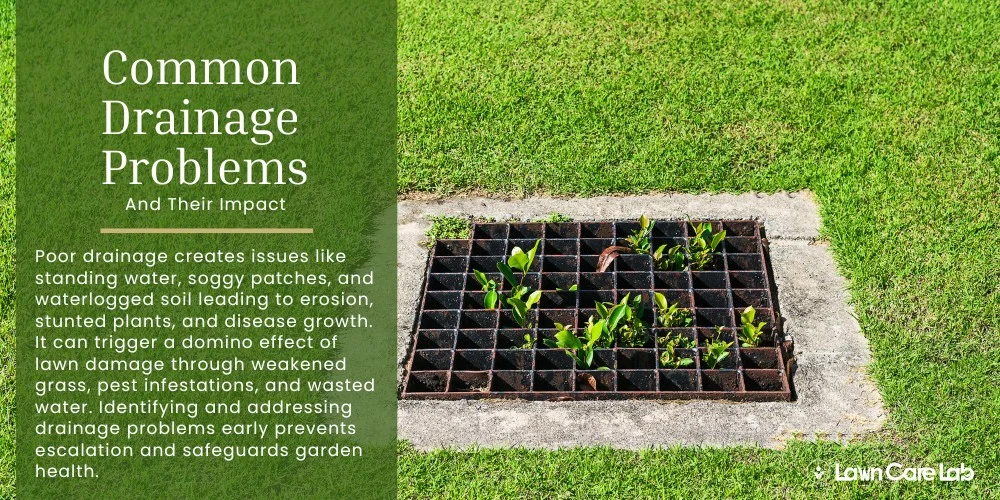
Ever seen standing water or drenched soil in your garden? Those are classic signs of drainage issues. Understanding that these problems can seriously damage your lawn’s health is vital.
Recognizing signs of poor drainage
If you spot constant pools of water or water-logged patches in your garden, it’s likely you have a drainage issue.
Long-term, this can harm your plants by suffocating their roots and promoting disease growth.
Identifying these signs promptly allows you to intervene and keep your garden vibrant and thriving quickly.
Puddles and waterlogging: Telltale signs
Persistent puddles and waterlogged plants indicate a lawn drainage issue in your lawn. These common issues can lead to soggy lawns and stunted plant growth, hinting at poor soil drainage.
The focus should be on preventing flooding and enhancing soil drainage. Possible solutions include creating raised beds for your plants, improving soil drainage, and installing drains to prevent erosion.
Now, let’s explore the relationship between water-saturated soil and the health of your plants.
The link between waterlogged soil and plant health
If you’re battling waterlogged soil in your garden, your plants may start to suffer. Poor drainage can cause soil erosion and stifle the roots, leading to wilting and death.
It’s important to sort out these drainage problems to keep your plants healthy.
The domino effect: How drainage issues affect lawn health
To prevent damage to your garden, it’s important to spot poor drainage early and make DIY fixes to prevent the issue from escalating.
Poor drainage can weaken grass, promote weed and disease growth, and attract pests like mosquitoes.
Excess water can also wash away soil and cause drainage issues, hampering water-saving efforts.
Solutions for Improved Lawn Drainage
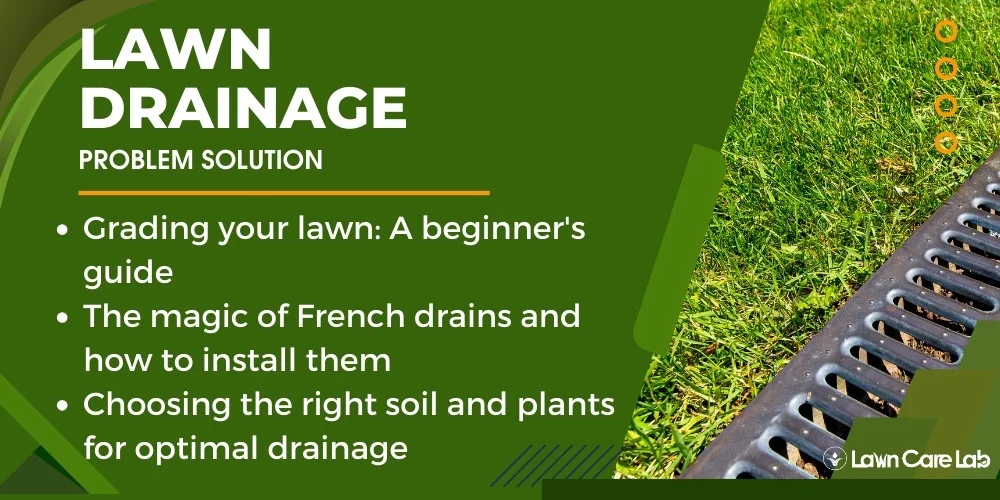
Discover effective solutions to improve your lawn drainage system with DIY techniques, proper soil selection, and appropriate vegetation.
DIY methods to enhance garden drainage
Want to boost your lawn’s drainage? Try out some do-it-yourself strategies.
A good starting point could be lawn grading, a simple technique that guides the water flow.
You might also find it useful to research French drains and understand their installation process for better lawn drainage.
Grading your lawn: A beginner’s guide
To ensure good drainage in your garden, learn about yard grading and the significance of a 1% slope. Use effective grading techniques to prevent water pooling.
Also, make sure you know what tools you’ll need. Steer clear of typical errors, and don’t hesitate to call in the pros if you find yourself in a pickle.
With these steps mastered, you’re on track for a well-drained, prosperous garden.
The magic of French drains and how to install them
French drains can boost your garden’s drainage system. Setting them up is easy, and they offer many advantages. Maintenance is simple, too.
When compared to other lawn drainage methods, French drains undoubtedly come out on top.
Let’s move on to picking the best soil and plants for maximum drainage.
Choosing the right soil and plants for optimal drainage
Giving your lawn a drainage boost involves a keen selection of soil and plants. The dynamics of your garden’s layout can be noticeably improved by paying attention to the type of soil and the plants you choose, as they play essential roles in drainage and maintenance.
By improving clay soils, adding compost can increase permeability and air circulation, promoting better drainage. Then, consider planting flora that enjoys moisture, such as irises, mint, or willow trees. These plants are naturally suited to damp environments and help prevent water saturation.
Choosing plants that are well-suited to your specific site is another smart move to ensure your garden design aids in drainage.
Lastly, watching your lawn’s overall health will help detect early signs of drainage issues. Ultimately, the secret to a thriving, well-drained lawn lies in the strategic choice of soil and plants.
The Environmental Benefits of Good Drainage
Taking care of your property’s water flow doesn’t just lead to a lush green lawn. It also helps the planet.
Top-notch drainage stops soil from being washed away, which is crucial for keeping the earth intact for our kids and grandkids.
Plus, it aids regional animals, making your garden a hot spot for biodiversity.
Preventing soil erosion and its importance
It’s crucial to grasp how soil wellness is linked to water-holding capacity. By promoting proper drainage, you’re not just saving water but also keeping soil erosion at bay.
This is vital not just for your garden’s wellbeing but also for our planet’s health. So, adopting efficient drainage methods can serve dual purposes – safeguarding your garden and helping the environment thrive.
The connection between soil health and water retention
The state of your ground can significantly impact water retention, which can affect how well your lawn drains and ward off soil erosion. Having a structured ground not only bolsters water conservation but also supports plant growth and keeps the ecosystem in equilibrium.
Want to boost your ground’s condition? Here’s what you can do:
- Introduce organic compost.
- Rotate your crops.
- Try mulching.
- Incorporate cover crops.
How can proper drainage conserve water?
Having the right drainage for your lawn isn’t just good for soil health, it’s also an excellent way to save water and prevent soil erosion – so it’s a win for the environment too.
You can improve drainage by using clever solutions like harvesting rainwater, laying permeable pavers, and building raised beds, swales, and berms.
Plus, underground drainage systems can be a great way to repurpose excess water, showing just how effective a well-designed drainage system can be.
Supporting local wildlife through effective water management
Don’t underestimate the value of your lawn’s drainage – it’s crucial for local wildlife. Here’s why:
- It boosts water savings, encourages biodiversity, and sustains ecosystem services.
- It’s a solid foundation for a green garden that’s also a lively wildlife sanctuary.
Here’s the deal:
- Effective drainage recharges local water tables, offering water supplies for animals.
- It nurtures plant life, which is vital for varied ecosystems.
- It also mimics natural water cycles via slow rainwater filtration into the soil.
- Plus, drainage channels that lead to rain gardens are home to diverse species.
Conclusion: The Road to a Healthier Lawn
Effective lawn drainage is essential on your path to a thriving lawn, not just an extra perk.
You can use grading methods to sculpt your land, ensuring quick water movement and averting soggy soil for flourishing greenery.
DIY methods like rainwater collection are clever ways to turn excess water into a useful asset.
Remember, aerating your soil is vital, too, as it provides air for plant roots, encouraging healthier and stronger growth.
Moreover, regular lawn care is key to making sure your drainage systems work at their best, making the most of every rainfall.
- How Green Spaces Influence Community Interactions - July 8, 2024
- Lawn Fungal Diseases: Identification and Treatment - July 3, 2024
- Lawn Care for All Seasons: A Year-Round Guide for Extreme Climates - June 24, 2024

